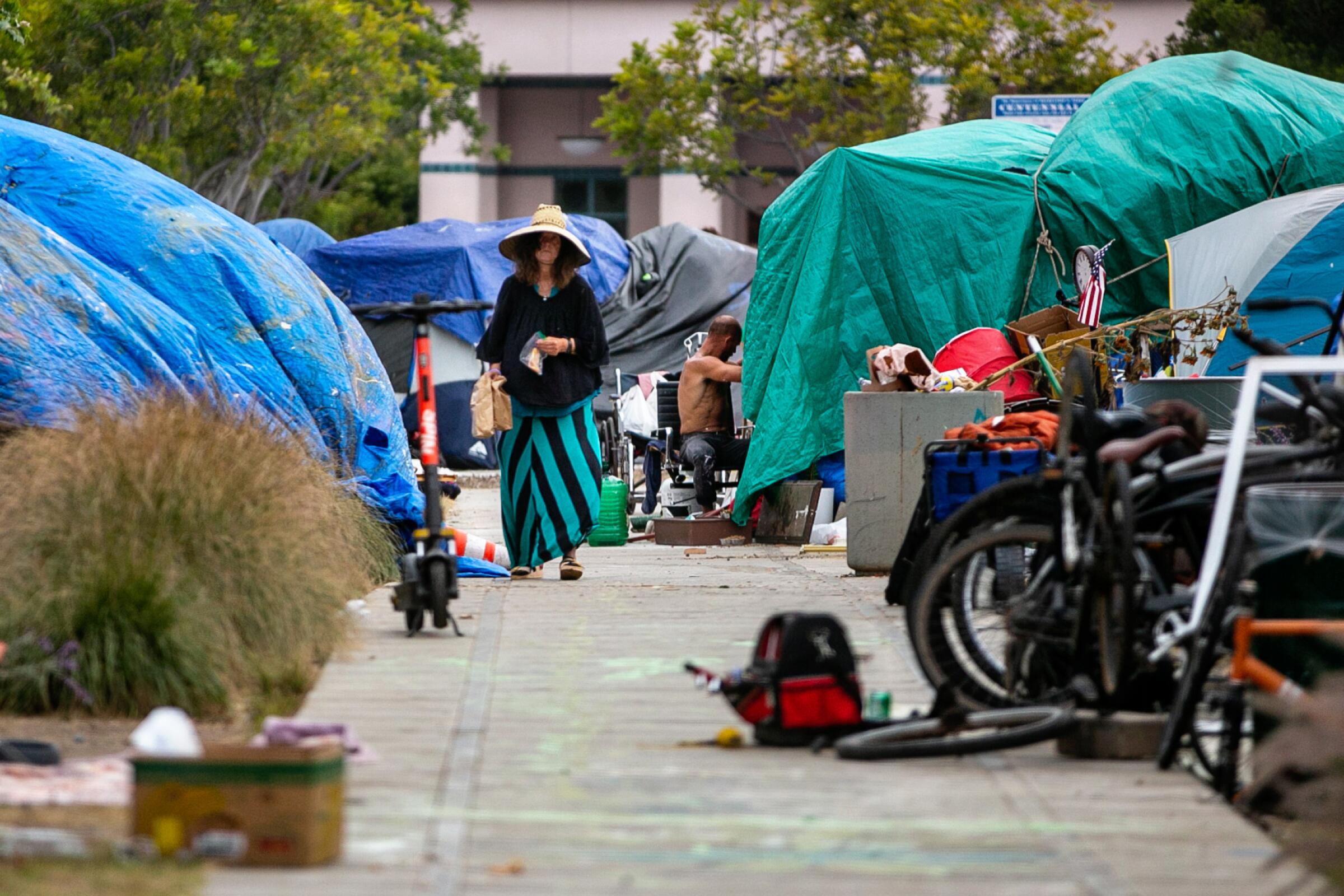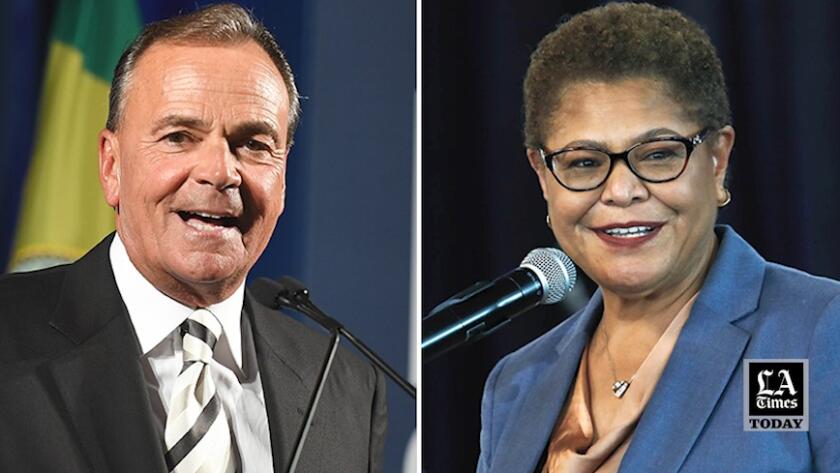Los Angeles mayoral candidates Karen Bass and Rick Caruso have each made sweeping promises about how they would solve the homelessness crisis on city streets, where as many as 41,000 people sleep in tents, RVs and other makeshift housing.
Both candidates recently sat down with Times reporters to discuss their proposals and flesh out details.
Both promise to get thousands of people off the city’s streets, but their plans diverge widely in scale and method.
Caruso focuses entirely on building new interim housing for 30,000 people in two initiatives, one using vacant government land and the other in underutilized buildings.
Bass outlined a nine-point plan she said would house more than 17,000 people by speeding up and expanding programs that already exist.
Here is a look at their proposals:
Caruso plan
Rick Caruso says he will build 30,000 new interim beds in 300 days at a onetime capital cost of $743 million to $874 million. He does not include operating costs , which he said should be paid by the county. This building would be on top of the interim and permanent housing that would be added through existing programs such as Proposition HHH. He breaks the plan into two equal pieces:
1
Tiny homes
Temporary, transportable outdoor structures measuring roughly 8 feet by 8 feet. They come with one, two or four beds. Caruso counts them as private shelter — one person per structure — but would allow sharing by choice.
Where: Surplus government land.
Caruso has a list of 300 properties that could be used but has not vetted them individually for feasibility. His campaign released a list of only 10 properties, seven owned by the city, two by the county and one by the state as examples. A few examples of the potential locations were a 124-acre parcel west of Los Angeles International Airport destined to become a rental car center, and a vacant lot west of USC.
2
Sleeping pods
Temporary, transportable structures assembled like office furniture inside existing buildings with walls separating sleeping areas.
Caruso’s campaign did not produce a list of potential sites or a specific manufacturer or design.
Where: Inside underutilized commercial and industrial or government buildings.
Funding sources
Caruso’s campaign did not specify where the money would come from but cited $700 million in homeless expenditures over the last two years, including $221 million in federal Emergency Solutions grants, $80 million from the state Homeless Emergency Aid Program, $120.9 million from the state Homeless Housing , Assistance and Prevention Program and $278.7 million in city funds.
These state and federal funding resources have been used to buy hotels and build shelters .
Caruso declined to estimate the operating expenses for housing 30,000 people, but a Times analysis of city documents found that it would cost about $660 million a year, or about $22,000 per person.
For Caruso, achieving this plan will also come down to speeding up and simplifying the permitting and development process for homeless housing, while also being more assertive with City Council members about selecting sites where these shelters and tiny homes would go.
Bass plan
Karen Bass says she will place 17,153 people indoors in her first year at a cost of $292 million, including both the capital cost and one year of operations for interim housing. The beds would be a combination of interim and permanent housing that already exists or is under construction, new housing and shelter, and thousands of market units using rental subsidies that have been issued but not yet used. Her plan has nine parts:
1
Emergency housing vouchers
Bass would secure 3,170 leased apartment or motel units using federal emergency housing vouchers.
The city received 3,365 emergency subsidies under the pandemic relief programs but had placed only 196 people in homes by July. Bass pledges to expand eligibility, streamline the application process and provide incentives to landlords.
Where: Market-rate apartments and motels across the city.
2
Master-leased buildings
Bass envisions securing 2,500 units in master - leased buildings
By leasing entire buildings, the city can incorporate food service and mental health and substance abuse treatment.
Where: Market-rate apartments and motels across the city.
3
Permanent units
The plan calls for 3,000 units in new buildings constructed under Proposition HHH.
Bass promises to streamline city processes to speed up projects receiving funds from the 2016 homeless housing bond. Currently, 2,000 units are scheduled for completion in 2023, so she is promising a 50% increase.
Where: New construction across the city.
4
Buildings purchased by the city
Project Homekey, a state program, would help the city acquire 700 apartment units in apartment buildings, hotels or motels.
Two rounds of state funding have allowed the city to purchase nearly 2,000 units in existing and some newly constructed buildings. Bass is counting on approval of the city’s application for a third round now in Gov. Gavin Newsom’s hands.
Where: Existing buildings or new construction around the city.
5
Existing interim housing
Bass’ plan anticipates freeing up 3,700 beds in existing interim housing.
She is counting shelter beds that are currently occupied but will become available as their current residents move into the 3,000 new Proposition HHH beds and the 700 new Project Roomkey beds in her plan.
Where: Existing shelters around the city.
6
New interim housing
Bass proposes building 1,000 new interim housing units: One-third tiny homes, one-third tent structures with individual cubicles and one-third modular construction.
Where: On government land.
Bass said they could be built on 73 acres of unused or underutilized city-owned land and more than 600 acres of land in the city owned by other government entities. Because the tiny homes the city purchases come with two beds, Bass is counting two placements for each unit — for a total of 666 people housed in 333 units. Though Bass does not support requiring people to share quarters, her staff said they are confident the tiny homes can be occupied by couples.
7
Mental health and substance use beds
Bass says she would clear the way for 750 beds at mental health and substance use facilities. She said she would work with Newsom and the federal government to end a restriction on Medicaid reimbursement for mental health facilities with more than 16 beds. This would allow large institutions such as the closed St. Vincent Medical Center to be converted to residential treatment centers.
8
Housing in converted buildings
Bass said she would update the city’s downtown adaptive reuse ordinance so that underutilized hotels, motels, office and retail buildings across the city could be converted into 500 housing units.
Where: In existing buildings across the city.
9
Housing vouchers for veterans
Bass said she would work with the U.S. Department of Veterans Affairs to eliminate roadblocks to free up 1,500 housing vouchers for veterans.
Where: In existing housing around the city.
Watch L.A. Times Today at 7 p.m. on Spectrum News 1 on Channel 1 or live stream on the Spectrum News App. Palos Verdes Peninsula and Orange County viewers can watch on Cox Systems on channel 99.














